The Parachromis is a genus of Cichlids native to Central America, more specifically in Lake Nicaragua and Lake Managua. They are predatory, aggressive, territorial, and relatively large. The smallest reaches about 12 inches and the biggest well over 28 inches.
The Parachromis is usually the Cichlid of choice for hardcore Chiclidophiles looking for large aggressive Fishes, and believe me, you will not be disappointed.
THE PARACHROMIS FIVE
There are currently five recognized species in the genus Parachromis.
PARACHROMIS DOVII

The Parachromis dovii, also known as the Wolf Cichlid, is easily the largest and meanest in the genus. They can grow 28 inches in length with a weight of six kilograms. They are aggressive and territorial and will not hesitate to beat up their tankmate.
They certainly make anyone’s list of the top 10 most aggressive freshwater Fishes.
Recently, a red variant, which could be a xanthic mutation, found their way
in the market. Instead of the familiar blue spots wild Wolf Cichlids have, they have red or orange spots.
PARACHROMIS MANAGUENSIS

The Parachromis managuensis, also known as the Jaguar Cichlid or Jaguar Guapote, is the second biggest in the genus. They reach a maximum size of 22 inches. They are highly adaptable, which is probably why they have populated the Philippine freshwater systems.
P. managuensis was first reported in Taal Lake in the early 2000s where locals referred to them as “Tilapu”, thinking they were a crossbreed between a Tilapia and a Lapu-Lapu.
The government, through the Bureau of Fisheries and Aquatic Resources, eventually stepped in and identified the “Tilapu” as P. managuensis. They have spread to many lakes and rivers in Luzon.
PARACHROMIS FRIEDRICHSTHALII

Also known as the Yellowjacket Cichlid, this Fish has a unique pattern compared to the rest. While the other species generally have a row of blotches arranged horizontally, the P. friedrichsthalii has a horizontal row of blotches, but they extend vertically above and below, thus appearing vertical. The markings contrast the golden-yellow body color.
The P. friedrichsthalii grows to a modest size of 12 inches.
PARACHROMIS MOTAGUENSIS

The Parachromis motaguensis, whom Filipino Cichlid keepers love to refer to as the Mota, is also impressive. Males can reach up to 12 inches, while females are much smaller.
In other countries, the P. motaguensis is called False Yellowjacket Cichlid. Two color variants are available: the natural- colored blue-and-grey variant and the red variant, with a reddish color all over.
PARACHROMIS LOISELLEI

Lastly, the Parachromis loisellei is the least popular among the five Parachromis species because they are rare. The males grow to a maximum size of 12 inches and the females, a few inches smaller.
Just like other Parachromis species, these Fishes are aggressive and will not hesitate to defend their territory against larger Fishes.
WHAT’S IN THE NAME?
While the four other species of Parachromis were scientifically described in the 1800s, the P. loisellei was discovered over a century later, in 1989.
Earlier specimens of P. loisellei were thought to be P. friedrichsthalii, until William Albert Bussing, an American ichthyologist from the Universidad de Costa Rica, reclassified them as Parachromis loisellei. They were named after well-known American aquarist Dr. Paul V. Loiselle.
P. loisellei is known under the common name Loiselle’s Cichlid in honor of one of the world’s greatest Cichlid authority.
ARE THEY REALLY LOISELLEI?

Of the five Parachromis species, the three smaller species often get mixed up. P. loisellei is sometimes confused with P. friedrichsthalii and P. motaguensis. They are similar in size and to the untrained eye, identifying the three correctly can be a challenge.
To differentiate P. loisellei from the other two species, you need to focus and look for the traits that are distinctly unique to the former. The Key Distinct Features (KDFs) are true only to P. loisellei and not found in P. friedrichsthalii or P. motaguensis.
Here are the KDFs present in P. loisellei:
BLACK BLOTCHES
These form a single horizontal row in the middle part of the body.
TWO TEAR MARKS
You can find these below the eyes.
TALL BODY AND ROUNDER SHAPE
They have a rounder shape compared to others in the genus.
A BLUISH-TURQUOISE HUE
This occurs above the lateral line. However, this is visible only in the males.
To add to these differences, P. friedrichsthalii markings form vertical bars, while the P. motaguensis has more markings above and below the horizontal markings.
SEXUAL DIMORPHISM
The sure way to determine their sex is by venting. As with all adult Cichlids, females have a bigger and wider “vent” because this tube is designed to deliver the much bigger eggs.
Meanwhile, the males have a thinner reproductive organ that delivers sperm.
An adult male may grow close to 12 inches, but the female is a lot smaller, perhaps less than 9 inches. Males are also bulkier.
Males also show more coloration than females. The blue hue above the lateral line is more intense, while females will turn yellow-gold color with plain or solid color fins. Males also develop longer fin extensions at the ends of the dorsal and anal fins.
In terms of behavior, adult males will patrol around the tank and claim a territory and will defend it. They will also do a courtship dance of flaring, fin extending, body shaking, and strutting to woo females in the area.
To check the vents, catch the Fishes and invert them. The vents are located between the ventral fins and the anal fins.
There are two holes between the fins: the anus and the vent. If both holes are small and seen as “o o” then the Fish is a male. If one of the holes is larger and looks like “o O” then they are female.

REPRODUCTION
Once a pair of P. loisellei is formed, this partnership will wreak havoc on their other tankmates. They may bully or kill their tankmates as they build their family. Provide lots of hiding spots for the female should she need them, as the male can become overly aggressive.
A stronger bond between the pair might develop, since they will both defend the brood from intruders. The pair will surely show teamwork while performing parental duties.
The pair will normally use flat rocks for their spawning surface. The female will lay a row of eggs and the male will follow to fertilize the eggs. This will be repeated many times over. Over a thousand eggs may be laid in a single brood.
After laying, both parents will guard the eggs against intruders and defend their territory to ensure the safety of their brood. The eggs hatch within three days and are at the wriggler stage for another two to three days. They will probably be transferred to a new and more secure nesting site.
The parents will care for their young up to the free-swimming stage, where they may be fed newly hatched brine Shrimp eggs or Daphnia.
WATER PARAMETERS
The P. loisellei, like most Cichlids coming from the Parachromis genus, is quite hardy and easy to keep in tanks with ordinary water conditions. They do best in slightly alkaline to alkaline water with a pH of 7.0 to 8.0. Philippine conditions are perfect for a Cichlid like P. loisellei.
They thrive in slightly hard to hard water, ranging from a hardness of
10 to 20 dH, and average water temperatures between 24°C (86°F)
to 30°C (75°F). Simply put, the water coming from your tap is perfect. There would be no need for you to alter these water parameters as these conditions most likely will fall within the ranges mentioned above.
TANK REQUIREMENTS
While the water parameters for keeping the P. loisellei is easy to achieve, I believe the biggest challenge in successfully caring for them at home is the tank size. While they are generally a medium to large Cichlid, they are quite aggressive and territorial. Hence, putting them in a big tank is a must.
I would recommend a tank size of at least 75 gallons if you will have 2 to 4 specimens. While it is no guarantee that you will be unsuccessful in a smaller tank, you will surely be faced with a lot more challenges in a relatively smaller tank than a bigger one, especially when they grow up. You will have even bigger problems when they mature.

If they do breed, you will have front row seats to experiencing the wrath of Cichlid parents protecting their brood from the tankmates, who would all try to fit themselves to the 1/5 section of the tank that is farthest from the nest.
To avoid such troubles, put the P. loisellei in the biggest tanks you can allot for them. Otherwise, you will just lose them one by one in a small tank, since they will eliminate the weaker ones until they are able to coexist amongst those left over.
Just because the P. loisellei is aggressive, this does not mean they cannot coexist in a community aquarium setup. A huge tank is a must if you will have a community of aggressive Fishes. There are many choices available. Forget the good guys; your tank will have to be a tough neighborhood. We are only considering Fishes who grow more than six inches, are aggressive, hardy, and fast.
The P. loisellei may be a challenge to take care of for someone caring for Fishes for the first time. But for those who like a tank full of tough guys, count this Cichlid in. They won’t be bashful in the tank and will probably swim proudly in their small corner in the tank, flaring, fin extending, body shaking, and strutting to show who is the boss.
POTENTIAL TANKMATES
Other Central American Cichlids, like those from the genera Vieja, Chiapaheros, and Amphilophhus are equally large, aggressive, and territorial. Hence, they make good candidates. Large South American Cichlids, like the Pike Cichlids (genus Crenicichla), Severums (genus Heros), Oscars (genus Astronotus), Green Terrors (Andinoacara rivulatus), and Parrot Cichlids (Hoplarchus psittacus) are also good tankmates.
Expect that fights will break out every now and then, so it would be a good idea to load the tanks with driftwood that can provide escape routes for bullied Cichlids.
Lage Tetras like Red Flagtail (Semaprochilodus insignis), Red Hooks (Myloplus rubripinnis), Black Barred Red Hook (Myleus schomburgkii), Silver Dollars (Metynnis argenteus), Striped Silver Dollars (Metynnis fasciatus) and Banded Leporinus (Leporinus fasciatus) can provide a lot of movement in the tank that would distract the Cichlids from one another.
Tough Catfishes, especially those with thick armor, are definite candidates to the tank. The untouchable Armored Catfishes like Pleco (Hypostomus plecostomus), Royal Plecos (genus Panaque), and Sailfin Pleco (Pterygoplichthys gibbiceps) are good algae eaters and are well protected with armor that can withstand the aggressiveness of these large Cichlids.
Thorny Catfishes like Irwini Catfish (Megalodoras uranoscopus), Ripsaw Catfish (Oxydoras niger), Granulated Catfish (Pterodoras granulosus), and the Striped Raphael Catfish (Platydoras armatulus) are also good choices.







